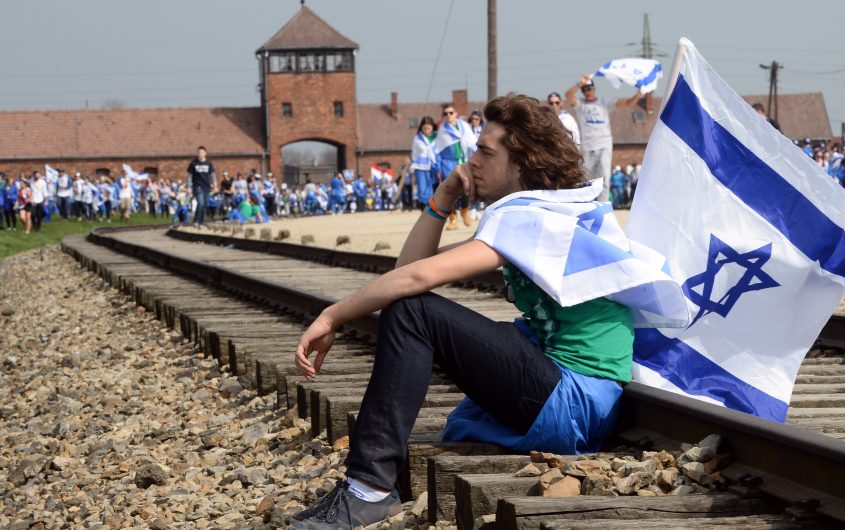
Auschwitz-Birkenau via JANEK SKARZYNSKI/AFP/Getty Images
A New Strategy for How the History of Nazism and the Holocaust Can Be Remembered by German, Israeli, and American Youth

Lily Gardner Feldman
Senior Fellow
Dr. Lily Gardner Feldman is a Senior Fellow at AICGS. She previously served as the Harry & Helen Gray Senior Fellow at AICGS and directed the Institute’s Society, Culture & Politics Program. She has a PhD in Political Science from MIT.
From 1978 until 1991, Dr. Gardner Feldman was a professor of political science (tenured) at Tufts University in Boston. She was also a Research Associate at Harvard University’s Center for European Studies, where she chaired the German Study Group and edited German Politics and Society; and a Research Fellow at Harvard University’s Center for International Affairs, where she chaired the Seminar on the European Community and undertook research in the University Consortium for Research on North America. From 1990 until 1995, Dr. Gardner Feldman was the first Research Director of AICGS and its Co-director in 1995. From 1995 until 1999, she was a Senior Scholar in Residence at the BMW Center for German and European Studies at Georgetown University. She returned to Johns Hopkins University in 1999.
Dr. Gardner Feldman has published widely in the U.S. and Europe on German foreign policy, German-Jewish relations, international reconciliation, non-state entities as foreign policy players, and the EU as an international actor. Her latest publications are: Germany’s Foreign Policy of Reconciliation: From Enmity to Amity, 2014; “Die Bedeutung zivilgesellschaftlicher und staatlicher Institutionen: Zur Vielfalt und Komplexität von Versöhnung,” in Corine Defrance and Ulrich Pfeil, eds., Verständigung und Versöhnung, 2016; and “The Limits and Opportunities of Reconciliation with West Germany During the Cold War: A Comparative Analysis of France, Israel, Poland and Czechoslovakia” in Hideki Kan, ed., The Transformation of the Cold War and the History Problem, 2017 (in Japanese). Her work on Germany’s foreign policy of reconciliation has led to lecture tours in Japan and South Korea.
Four factors make urgent the necessity of German, Israeli, and American youth actively remembering Germany’s history of Nazism and the Holocaust. First, in both Germany and the U.S., there have been increases in anti-Semitism in attitudes and actions, as demonstrated in anti-Semitic and anti-Israel protests. Second, anti-Semitism is more pronounced among minorities—Muslim German refugees and Hispanic Americans. Moreover, these minorities will become in the next ten years the most dynamic segments of both societies. Third, the witness generation, which experienced first-hand the horrors of the Holocaust, is rapidly dwindling. Fourth, there is a widening gap between the German government’s support of Israel and the increasingly negative attitudes of German public opinion toward the Jewish state.
Germany’s culture of remembrance (Erinnerungskultur) and confrontation with the past (Vergangenheitsbewältigung) have been neither linear nor easy. However, over seven decades Germany has demonstrated its impressive capacity to draw lessons from history both at home in the development of values, norms, and policies and abroad in its “special relationship” with Israel. Central to the success of both expressions of historical consciousness has been the education of young Germans in schoolrooms and at concentration camps and in youth exchange programs with victim nations. Nonetheless, the robustness of these achievements appears challenged today.
In the twenty-first century, anti-Semitism has moved from the fringes of German and American societies to the mainstream and has been institutionalized. In the U.S., incidents of anti-Semitism have increased with the rise of the “Alt-Right” (Alternative Right), a loose collection of white supremacists, even as anti-Semitic attitudes in the general population increased only slightly from 2016 to 2017. In Germany, the xenophobic and anti-Semitic AfD (Alternative für Deutschland), has grown into a political party with seats in the Bundestag. Anti-Semitic incidents in Germany continued to increase from 654 to 681 in the first half of 2017. Even though overt anti-Semitic attitudes are found in only 9 percent of the German population, milder forms of anti-Semitic prejudice are seen in 50 percent of those surveyed. Added to this is the result of a 2014 poll commissioned by the Bertelsmann Stiftung that 60 percent of respondents thought a line should be drawn under the past. However, a more recent survey commissioned by the foundation Remembrance, Responsibility, and Future (Stiftung Erinnerung, Verantwortung und Zukunft – EVZ) suggested that 54 percent of the respondents (37% strongly, 17% somewhat strongly) opposed an active and purposeful fading of history. In both Germany and the U.S., the extreme right has used the tool of demonstrations to express anti-Semitic sentiments. In Germany, Palestinian and Arab demonstrators have attacked the state of Israel and burned Israeli flags. The severity of the problem has spurred the Bundestag to create a position for a Commissioner against Anti-Semitism. The German chancellor has said that Germans should be “ashamed” of anti-Semitism. In the U.S., by contrast, the president has termed some of the demonstrators “very fine people.”
The current agents of anti-Semitism are also noteworthy. According to a survey of attitudes of Syrian and Iraqi migrants sponsored by the American Jewish Committee Berlin, anti-Semitism is pronounced among Muslim refugees in Germany. A larger study to be published in April by the Stiftung EVZ and the Pears Institute of the University of London, to be published in April, should shed further light on whether there is a connection between minorities and anti-Semitism across Europe. An Anti-Defamation League survey conducted in 2016 revealed that Hispanic Americans born outside the U.S. expressed more anti-Semitic attitudes (31%) than the general American population (14%). In a separate poll, 34 percent of American Muslims held anti-Semitic views, which is considerably less than European Muslims (55%).
The significant transformation in anti-Semitism’s content and expression is occurring at a time of dramatic changes among the victims of the Holocaust. The witness generation is disappearing fast. Programs to promote understanding of Germany’s past have been able to rely until now on survivors to tell their stories of immense suffering, persecution, and loss and to keep memory alive. The number of Holocaust survivors worldwide was estimated at only 100,000 in 2016. The numbers are quickly dwindling such that programmatic efforts involving the younger generation as the bridge between past and future should be re-doubled. According to a survey commissioned by the Kõrber Stiftung in 2017, 4 out of 10 young people know nothing about Auschwitz. Engaging young minorities, who have little or no familiarity with Germany’s Nazi history and the Holocaust, is vital while there are still survivors. Designing new programs for the time when no or few survivors are alive becomes critical. Such efforts should fall on fertile ground: in the EVZ survey 82 percent of those polled thought it very important that young people in school should learn about the extermination of concentration camp victims.
New ideas and programs also seem essential given the marked difference between German officialdom and the German public concerning the state of Israel. According to Chancellor Merkel and many German cabinet ministers and politicians, supporting the existence of the state of Israel is part of contemporary Germany’s DNA and national interest (Staatsräson). Such support does not preclude German official criticism of Israeli policy toward the Palestinians but the tone and level of official criticism do not match the depth, shrillness, and negativity of public attitudes. At times, Israeli behavior toward the Palestinians is equated by German opponents of Israel with German treatment of the Jews during Nazism, thereby denying the singularity and uniqueness of the Holocaust. A recent survey illustrated a range of negative German opinions about Israel: 70 percent believed Israel is driven by its own interests without consideration of other people; 59 percent deemed Israel an aggressive country; for 58 percent of those polled Israel remained a foreign country. Only 36 percent viewed Israel as a sympathetic country.
The challenges to memory and remembrance delineated above require a focused response with six separate goals:
- To identify the challenges in continuing to honor victims when so few are left
- To articulate the concrete steps that can be taken to institutionalize for the long term the practice of remembrance at the governmental and societal levels
- To specify the practical role that young people can play in bridging the past and the future and becoming agents of memory
- To draw lessons from the past that possess relevance for the every-day life of youth in the twenty-first century
- To develop an international network of young people for ongoing discussions of remembrance
- To set out a strategy for combating the denial of what happened in Germany, the biggest obstacle to honoring the witness generation of victims
To address these goals, continued activism by civil society in Germany and the U.S. is needed.







